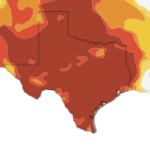The Final Numbers Are In: Over 300 Million Trees Killed By the Texas Drought

Photo by Dan Kitwood/Getty Images
Over 300 million forested trees have been lost to the Texas drought.
The tally of the Texas drought‘s toll continues. After an extensive survey, the Texas A&M Forest Service today puts the number of rural trees killed by the Texas drought at 301 million. That falls right in the middle of a December 2011 estimate by the service that between 100 and 500 million trees had been killed by the drought.
The survey only applies to trees in rural forest areas. The number of trees in urban settings that were lost to the drought was pegged at over five million earlier this year.
A&M Forest Service conducted the study by using on-the-ground research as well as satellite imagery. It includes not just trees that were directly killed by the drought, but also trees that died because they became more susceptible to disease or infestation because of stress from the drought.
The Texas A&M Forest Service says that there is some good news here, though.
“When a dead tree falls over, a young, new tree eventually will grow back in its place,” Burl Carraway, department head for the Texas A&M Forest Service Sustainable Forestry department, says in the survey’s announcement. “Tree death is a natural forest process. We just had more last year than previous years.”
The service says some parts of the state had bigger loses than others, with the Brazos Valley region being the hardest hit. It lost nearly ten percent of its forest trees. The situation was nearly as bad in parts of North and Northeast Texas, which lost over eight percent of their forest trees.
This map shows the various regions studied, with their respective losses:
“So what’s the fate of these trees? The vast majority are going to stand out there — until they eventually fall to the ground,” Texas A&M Forest Service Analyst Chris Edgar says in the survey’s announcement. Edgar estimates that there were already nearly 300 million standing dead trees in Texas before the drought. So after the drought, the number of dead trees in the state has almost doubled. The service recommends removing any standing dead trees “near homes or recreation areas.”
And there are some upsides to all that dead wood. “The standing, dead trees will provide additional habitats for insects, birds and wildlife,” the service says. “Fallen trees will do the same, while also adding structure to the forest floor which helps prevent soil erosion.”
But there are some downsides, too. The service says those trees have trapped a lot of carbon, which they will begin to release now that they’re dead. And they could serve as fuel to wildfires. For that reason, they recommend removing any standing dead trees near homes or recreation areas.
You can read more about the impact of the Texas 2011 drought at our interactive webpage.


